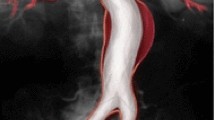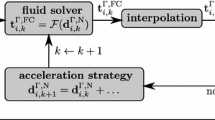Abstract
This work focuses on the derivation and the analysis of a novel, strongly-coupled partitioned method for fluid–structure interaction problems. The flow is assumed to be viscous and incompressible, and the structure is modeled using linear elastodynamics equations. We assume that the structure is thick, i.e., modeled using the same number of spatial dimensions as fluid. Our newly developed numerical method is based on Robin boundary conditions, as well as on the refactorization of the Cauchy’s one-legged ‘\(\theta \)-like’ method, written as a sequence of Backward Euler–Forward Euler steps used to discretize the problem in time. This family of methods, parametrized by \(\theta \), is B-stable for any \(\theta \in [\frac{1}{2} , 1]\) and second-order accurate for \(\theta = \frac{1}{2} + {\mathcal {O}}(\tau )\), where \(\tau \) is the time step. In the proposed algorithm, the fluid and structure sub-problems, discretized using the Backward Euler scheme, are first solved iteratively until convergence. Then, the variables are linearly extrapolated, equivalent to solving Forward Euler problems. We prove that the iterative procedure is convergent, and that the proposed method is stable provided \(\theta \in [\frac{1}{2},1]\). Numerical examples, based on the finite element discretization in space, explore convergence rates using different values of parameters in the problem, and compare our method to other strongly-coupled partitioned schemes from the literature. We also compare our method to both a monolithic and a non-iterative partitioned solver on a benchmark problem with parameters within the physiological range of blood flow, obtaining an excellent agreement with the monolithic scheme.









Similar content being viewed by others
References
Badia, S., Nobile, F., Vergara, C.: Fluid–structure partitioned procedures based on Robin transmission conditions. J. Comput. Phys. 227, 7027–7051 (2008)
Badia, S., Nobile, F., Vergara, C.: Robin–Robin preconditioned Krylov methods for fluid–structure interaction problems. Comput. Methods Appl. Mech. Eng. 198(33), 2768–2784 (2009)
Baek, H., Karniadakis, G.: A convergence study of a new partitioned fluid–structure interaction algorithm based on fictitious mass and damping. J. Comput. Phys. 231(2), 629–652 (2012)
Banks, J., Henshaw, W., Schwendeman, D.: An analysis of a new stable partitioned algorithm for FSI problems. Part I: incompressible flow and elastic solids. J. Comput. Phys. 269, 108–137 (2014)
Banks, J., Henshaw, W., Schwendeman, D.: An analysis of a new stable partitioned algorithm for FSI problems. Part II: incompressible flow and structural shells. J. Comput. Phys. 268, 399–416 (2014)
Bathe, K.-J., Zhang, H.: Finite element developments for general fluid flows with structural interactions. Int. J. Numer. Methods Eng. 60(1), 213–232 (2004)
Bazilevs, Y., Calo, V., Hughes, T., Zhang, Y.: Isogeometric fluid–structure interaction: theory, algorithms, and computations. Comput. Mech. 43(1), 3–37 (2008)
Bukač, M., Čanić, S., Glowinski, R., Muha, B., Quaini, A.: A modular, operator-splitting scheme for fluid–structure interaction problems with thick structures. Int. J. Numer. Methods Fluids 74(8), 577–604 (2014)
Bukač, M., Čanić, S., Muha, B.: A partitioned scheme for fluid–composite structure interaction problems. J. Comput. Phys. 281, 493–517 (2015)
Bukac, M., Muha, B.: Stability and convergence analysis of the extensions of the kinematically coupled scheme for the fluid–structure interaction. SIAM J. Numer. Anal. 54(5), 3032–3061 (2016)
Bukač, M., Yotov, I., Zunino, P.: An operator splitting approach for the interaction between a fluid and a multilayered poroelastic structure. Numer. Methods Partial Differ. Equ. 31(4), 1054–1100 (2015)
Burkardt, J., Trenchea, C.: Refactorization of the midpoint rule. Appl. Math. Lett. 107, 106438 (2020)
Burman, E., Durst, R., Fernández, M., Guzmán, J.: Fully discrete loosely coupled Robin-Robin scheme for incompressible fluid-structure interaction: stability and error analysis (2020). arXiv:2007.03846
Burman, E., Durst, R., Guzman, J.: Stability and error analysis of a splitting method using Robin–Robin coupling applied to a fluid–structure interaction problem (2019). arXiv:1911.06760
Burman, E., Fernández, M.: Stabilization of explicit coupling in fluid–structure interaction involving fluid incompressibility. Comput. Methods Appl. Mech. Eng. 198, 766–784 (2009)
Burman, E., Fernández, M.: Explicit strategies for incompressible fluid-structure interaction problems: Nitsche type mortaring versus Robin–Robin coupling. Int. J. Numer. Meth. Eng. 97(10), 739–758 (2014)
Burman, E., Fernández, M.: An unfitted Nitsche method for incompressible fluid–structure interaction using overlapping meshes. Comput. Methods Appl. Mech. Eng. 279, 497–514 (2014)
Cauchy, A.-L., Équations différentielles ordinaires. Éditions Études Vivantes, Ltée., Ville Saint-Laurent, QC; Johnson Reprint Corp., New York, Unpublished course. Fragment, With a preface by J. Dieudonné, With an introduction by C. Gilain (1981)
Causin, P., Gerbeau, J.F., Nobile, F.: Added-mass effect in the design of partitioned algorithms for fluid–structure problems. Comput. Methods Appl. Mech. Eng. 194(42–44), 4506–4527 (2005)
Crank, J., Nicolson, P.: A practical method for numerical evaluation of solutions of partial differential equations of the heat-conduction type. In: Mathematical Proceedings of the Cambridge Philosophical Society, vol. 43, pp. 50–67. Cambridge University Press (1947)
Dahlquist, G., Liniger, W., Nevanlinna, O.: Stability of two-step methods for variable integration steps. SIAM J. Numer. Anal. 20(5), 1071–1085 (1983)
Degroote, J.: On the similarity between Dirichlet–Neumann with interface artificial compressibility and Robin–Neumann schemes for the solution of fluid–structure interaction problems. J. Comput. Phys. 230(17), 6399–6403 (2011)
Degroote, J., Bruggeman, P., Haelterman, R., Vierendeels, J.: Stability of a coupling technique for partitioned solvers in FSI applications. Comput. Struct. 86(23), 2224–2234 (2008)
Deparis, S., Fernández, M., Formaggia, L.: Acceleration of a fixed point algorithm for fluid–structure interaction using transpiration conditions. ESAIM: Mathematical Modelling and Numerical Analysis-Modélisation Mathématique et Analyse Numérique 37(4), 601–616 (2003)
Farhat, C., Van der Zee, K., Geuzaine, P.: Provably second-order time-accurate loosely-coupled solution algorithms for transient nonlinear computational aeroelasticity. Comput. Methods Appl. Mech. Eng. 195(17), 1973–2001 (2006)
Fernández, M.: Incremental displacement-correction schemes for incompressible fluid–structure interaction: stability and convergence analysis. Numer. Math. 123, 210–65 (2012)
Fernández, M., Landajuela, M.: A fully decoupled scheme for the interaction of a thin-walled structure with an incompressible fluid. C.R. Math. 351(3–4), 161–164 (2013)
Fernández, M., Mullaert, J., Vidrascu, M.: Generalized Robin–Neumann explicit coupling schemes for incompressible fluid-structure interaction: stability analysis and numerics. Int. J. Numer. Methods Eng. 101(3), 199–229 (2015)
Formaggia, L., Quarteroni, A., Veneziani, A.: Cardiovascular Mathematics: Modeling and Simulation of the Circulatory System, vol. 1. Springer, Berlin (2010)
Gee, M., Küttler, U., Wall, W.: Truly monolithic algebraic multigrid for fluid–structure interaction. Int. J. Numer. Methods Eng. 85(8), 987–1016 (2011)
Gerardo-Giorda, L., Nobile, F., Vergara, C.: Analysis and optimization of Robin–Robin partitioned procedures in fluid–structure interaction problems. SIAM J. Numer. Anal. 48(6), 2091–2116 (2010)
Gerbeau, J.-F., Vidrascu, M.: A Quasi–Newton algorithm based on a reduced model for fluid–structure interaction problems in blood flows. ESAIM: Mathematical Modelling and Numerical Analysis-Modélisation Mathématique et Analyse Numérique 37(4), 631–647 (2003)
Gigante, G., Vergara, C.: On the stability of a loosely-coupled scheme based on a Robin interface condition for fluid–structure interaction (2019). arXiv:1905.06593
Girault, V., Raviart, P.-A.: Finite Element Approximation of the Navier–Stokes Equations. Lecture Notes in Mathematics, p. 749. Springer, Berlin (1979)
Hansbo, P.: Nitsche’s method for interface problems in computational mechanics. GAMM-Mitt. 28(2), 183–206 (2005)
Hecht, F.: New development in FreeFem++. J. Numer. Math. 20(3–4), 251–266 (2012)
Hron, J., Turek, S.: A Monolithic FEM/Multigrid Solver for an ALE Formulation of Fluid-Structure Interaction with Applications in Biomechanics. In: Fluid–Structure Interaction. volume 53 of Lecture Notes in Computational Science and Engineering, pp. 146–170. Springer, Berlin (2006)
Hundsdorfer, W., Verwer, J.: Numerical Solution of Time-Dependent Advection–Diffusion–Reaction Equations, vol. 33. Springer, Berlin (2013)
Langer, U., Yang, H.: Numerical simulation of fluid–structure interaction problems with hyperelastic models: a monolithic approach. Math. Comput. Simul. 145, 186–208 (2018)
Lukáčová-Medvid’ová, M., Rusnáková, G., Hundertmark-Zaušková, A.: Kinematic splitting algorithm for fluid–structure interaction in hemodynamics. Comput. Methods Appl. Mech. Eng. 265, 83–106 (2013)
Muha, B., Čanić, S.: Existence of a solution to a fluid-multi-layered-structure interaction problem. J. Differ. Equ. 256(2), 658–706 (2014)
Nobile, F.: Numerical approximation of fluid–structure interaction problems with application to haemodynamics. Ph.D. thesis, EPFL, Switzerland (2001)
Nobile, F., Vergara, C.: An effective fluid–structure interaction formulation for vascular dynamics by generalized Robin conditions. SIAM J. Sci. Comput. 30, 731–763 (2008)
Oyekole, O., Trenchea, C., Bukač, M.: A second-order in time approximation of fluid–structure interaction problem. SIAM J. Numer. Anal. 56(1), 590–613 (2018)
Ryzhakov, P., Rossi, R., Idelsohn, S., Oñate, E.: A monolithic Lagrangian approach for fluid–structure interaction problems. Comput. Mech. 46(6), 883–899 (2010)
Seboldt, A., Bukač, M.: A non-iterative domain decomposition method for the interaction between a fluid and a thick structure (2020). arXiv:2007.00781
Serino, D., Banks, J., Henshaw, W., Schwendeman, D.: A stable added-mass partitioned (AMP) algorithm for elastic solids and incompressible flow: model problem analysis. SIAM J. Sci. Comput. 41(4), A2464–A2484 (2019)
Stetter, H.: Analysis of Discretization Methods for Ordinary Differential Equations, vol. 23. Springer, Berlin (1973)
Yu, Y., Baek, H., Karniadakis, G.: Generalized fictitious methods for fluid–structure interactions: analysis and simulations. J. Comput. Phys. 245, 317–346 (2013)
Acknowledgements
This work was partially supported by NSF under Grants DMS 1912908 and DCSD 1934300.
Author information
Authors and Affiliations
Corresponding author
Ethics declarations
Conflict of interest
The authors declare that they have no conflict of interest.
Additional information
Communicated by F. Gazzola.
Publisher's Note
Springer Nature remains neutral with regard to jurisdictional claims in published maps and institutional affiliations.
Rights and permissions
About this article
Cite this article
Bukač, M., Seboldt, A. & Trenchea, C. Refactorization of Cauchy’s Method: A Second-Order Partitioned Method for Fluid–Thick Structure Interaction Problems. J. Math. Fluid Mech. 23, 64 (2021). https://doi.org/10.1007/s00021-021-00593-z
Accepted:
Published:
DOI: https://doi.org/10.1007/s00021-021-00593-z




